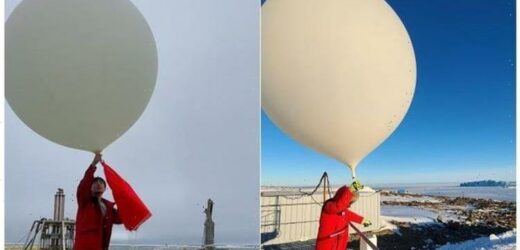Hole in the ozone layer increased hugely in 2021 show charts
We use your sign-up to provide content in ways you’ve consented to and to improve our understanding of you. This may include adverts from us and 3rd parties based on our understanding. You can unsubscribe at any time. More info
This hole that was created in the ozone layer of Earth’s atmosphere will be the third longest-lasting one in over four decades. The Earth’s ozone layer lies within the lower lever of the stratosphere at approximately 15 to 35 kilometres above Earth.
This thin layer protects life on earth by absorbing most of the Sun’s harmful ultraviolet radiation.
In 1976, scientists discovered that this protective layer was being damaged by chemicals released by industry, mainly chlorofluorocarbons (CFCs).
Atmospheric research revealed that this depletion was much higher than could be accounted for by natural causes like temperature, weather and volcanic eruptions.
As the ozone layer provided less protection, the UV radiation threatened life on Earth, including increased skin cancer and cataract rates in humans and other ecological problems.


Every year a large hole opens up in the ozone layer during the southern hemisphere’s summer.
Meanwhile, the size of the annual hole depends on a range of weather conditions and is augmented by cold.
However, experts predict that these holes will close for good by 2050, as a result of a global restriction on ozone-depleting chemicals introduced in the late 80s.
In 1987, countries around the world signed the Montreal Protocol that capped the production of CFCs at 1986 levels with commitments to long-term reductions.

According to former UN Secretary-General Kofi Annan: “perhaps the single most successful international agreement to date has been the Montreal Protocol”
According to the European Centre for Medium-Range Weather Forecasts (ECMWF), the hole formed in the ozone layer this year was the 9th largest on record, reaching 8.8 million square miles.
At its maximum level, the hole was as large as the area of Antarctica and Europe combined.
ECMWF’s Copernicus Atmosphere Monitoring Service (CAMS) director Vincent-Henri Peuch said: “Both the 2020 and 2021 Antarctic ozone holes have been rather large and exceptionally long-lived.
DON’T MISS:
Archaeologists stunned at shipwreck ‘frozen in time'[SPOTLIGHT]
Truss in furious Brexit showdown as EU threaten £80bn betrayal [INSIGHT]
David Attenborough stunned by archaeological goldmine in UK [REVEAL]


“These two longer-than-usual episodes in a row are not a sign that the Montreal Protocol is not working though, as without it, they would have been even larger.
“It is because of interannual variability due to meteorological and dynamical conditions that can have an important impact on the magnitude of the ozone hole and are superimposed on the long-term recovery.
CAMS also tracks the amount of UV radiation that reaches the Earth’s surface and recently they have observed very high UV indexes, in excess of 8, over parts of Antarctica situated below the ozone hole.
The UV index forecast identifies the strength of the ultraviolet radiation coming from the sun at a particular point.
The index ranges on a scale of 1-11, with 8 being labelled “very high”.
Source: Read Full Article


